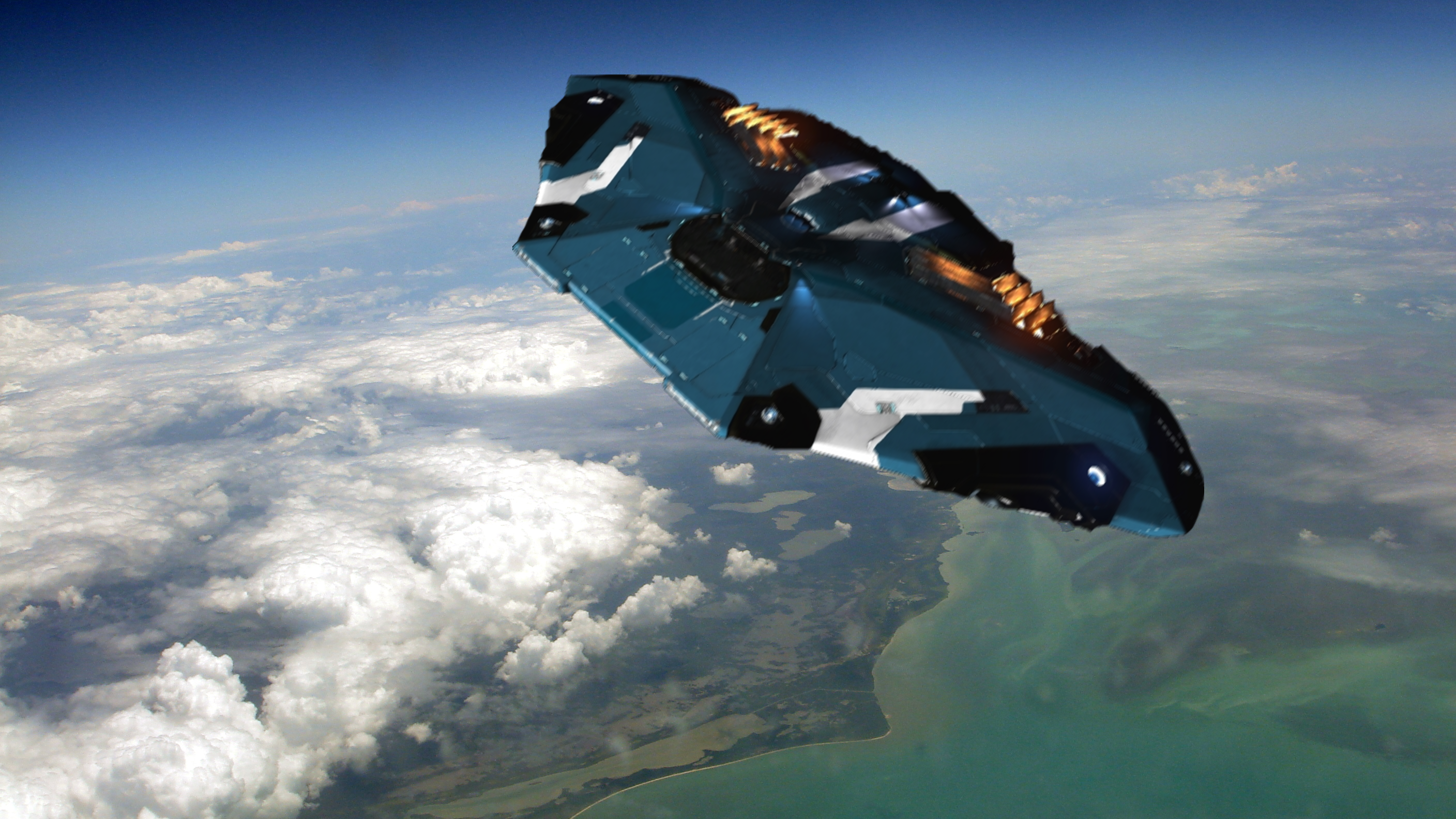A blazar is an active galactic nucleus (AGN) with a relativistic jet (a jet composed of ionized matter traveling at nearly the speed of light) directed towards an observer.
Blazars are powerful sources of emission across the electromagnetic spectrum and are observed to be sources of high-energy gamma ray photons.
Blazars are highly variable sources, often undergoing rapid and dramatic fluctuations in brightness on short timescales (hours to days).
In 2009, a team of astronomers using the Swift spacecraft used the luminosity of S5 0014+81 to measure the mass of its super-massive black hole. They found it to be about 10,000 times more massive than the black hole at the center of our galaxy, or equivalent to 40 billion solar masses
Literally inconceivable. Our minds aren’t capable of really grasping what that size is like.
“Space is big. You just won’t believe how vastly, hugely, mind-bogglingly big it is. I mean, you may think it’s a long way down the road to the chemist’s, but that’s just peanuts to space.”
– Douglas Adams
It took up most of my phone screen! Inconceivable!
Jk
Reminds me of the discussion between the gunslinger and the man in black in ‘the dark tower’
You say true, I say thank you.
From wikipedia
The central black hole of the quasar devours an extremely huge amount of matter, equivalent to 4,000 solar masses of material every year.
It is 25,000 times more luminous than all the stars in the milky way galaxy combined.
Those two facts are mind bogglingly insane.
Imagine orbiting this thing. Watching it. Watching 11 stars a day worth of matter spiralling into it: every 2 hours, you can look up and an entire star, power and mass equivalent to our life-giving sun, is now inside the event horizon, gone forever, lost to time itself.
He has sat immobile, His body slowly crumbling, for over 10,000 standard years. His shattered, decaying body can no longer support life, and it is kept intact only by the cybernetic mechanisms and sustained by the daily sacrifice of thousands of lives.
The counter-intuitive part of super-massive blackholes is that because the event horizon (point of no return) is so large it is possible to cross it without yet suffering any obvious effects. You are “alive” (for a while) passed the point of no return but will never be seen by the rest of the universe again.
Where as with smaller black holes the rate of gravity increase at the event horizon it much. much higher. This means you would be dead before crossing.
couldn’t you theoretically time travel forward by getting close to this super massive backhole changing out for a while then leaving, assuming you have the technology to do the leaving part
IIRC: Time dilation does kick in if you orbit very close to the event horizon but this is more to do with the fact you would have to be travelling at a reasonable percent of the speed of light to do so than is does the black hole.
Ie: you would get the same time dilation travelling at the same speed in a straight line.
But once you cross the event horizon, there in nothing in our current understanding of physics (including using wormholes etc ) that can bring you back.
Stargate led me to believe the strong gravitational forces of the blackhole would affect how fast time passes, meaning the closer you get to a blackhole the less time it elapses for you compared to people observing from afar not affected by the gravitational forces.
Stargate, while a good series, is not the place to go for accurate information on astrophysics.
Intense gravity does not cause time dilation. This only happens when a mass is accelerated to a relativistic velocity.
This is the equation to calculate time dilation:
Time dilation factor = the square root of (1 - (v2/C2))
v = velocity of the mass.
C = speed of light.
The only thing that affects time dilation is the velocity of the mass compared to the speed of light.
The gravity affecting the mass is irrelevant.
It sounds like the stargate writers were told “Orbiting close to a black hole can cause time dilation” but what they heard was “being close to a black hole causes time dilation, black holes have high gravity…therefore being in a strong gravity field causes time dilation”
Except gravitational time dilation is absolutely a thing: https://en.m.wikipedia.org/wiki/Gravitational_time_dilation
deleted by creator
r/TIL! Thanks for the in depth explanation, people like you are precious and make lemmy worth browsing!
I mean, a random person on the internet isn’t any more reliable as a source of accurate information than a tv show is. Gravitational time dilation really is a thing that occurs, so time dilation is affected by the mass/gravity of an object if the object is massive enough: https://en.m.wikipedia.org/wiki/Gravitational_time_dilation
deleted by creator
Does having a lot of white privilege help around black holes?
is that its actuall size or the size of its event horizon?
The event horizon, as the singularity inside it is infinitely compressed, and is the smallest something can be, even smaller than a planck length which is the smallest possible measurement.
That’s speculation. We don’t know the nature of the singularity or even if it is a singularity.
The calculations using general relativity clearly show that past a certain mass the curvature of space time becomes infinitely compressed and so gravity at this point is also infinite.
While we are unable to observe this singularity due to the laws of physics this is not a controversial understanding.
https://www.einstein-online.info/en/spotlight/the-singularity-theorem/
We don’t know anything. The point of science is to know what we don’t know.
I’m not sure there’s a other way to really describe the size of a black hike other than mass or the Schwarzschild radius (the radius to the event horizon.
“Is that Neptune’s orbit or Pluto’s?”
“Sure, whatever.”
It is likely to be neither. The last major or minor planet is not the edge of the solar system.
The size of the solar system is much larger than that.
One definition is the outer limit of the oort cloud. ( the furthest objects in orbit around the sun)
Pluto is, on average 39 AU (AU = sun to earth distance) from the sun.
The Oort cloud starts at ~20,000 AU and finishes at 200,000 AU.
Another is the Heliopause.
The heilopause is the volume of a bubble of space that is filled with the solar wind. At the heliopause the outward solar wind pressure is balanced with the pressure of the interstellar medium.
That is at about 120 AU.
If they used the heilopause: the circle is 4 times bigger than the orbit of Pluto.
If they used the Oort cloud, the circle is 500 times bigger than the orbit of Pluto.
You are right scientifically, but since this was probably made for the public, the orbits of the planets tend to be what is pictured as “the solar system”. Anyway, given the scale presented, all these different boundaries still look like a dot so it doesn’t matter.
Isn’t TON 618 the largest black hole? It’s almost twoce the size Or am I confusing something?
TON 618 is the largest super massive black hole that’s mass has been measured, two are claimed to be larger based on estimations.
There’s probably a Yo Mama joke here…
I’m no spacey star science guy, but does anyone else find it odd that nuclei are like little sun’s or black holes even because they are so dense and protons electrons and neutrons all have an… let’s call it an orbit around them like little planets. It can’t be a coincidence, right??
To take this one step further.
The three things we need to completely describe an elementary particle. (proton, neutron, electron, anti-proton, etc)
Mass.
Charge.
Spin.
The three things we need to completely describe a black hole.
Mass.
Charge.
Spin.
It is pretty interesting!
To be fair, the orbit of electrons (neutrons are actually in the centre with the protons, not orbiting the nucleus) are nothing like planets. They’re more like what happens when a cat gets stuck in a plastic bag and starts rocketing around the house at Mach 500. Their movement is so unpredictable that we can never actually say for sure where an electron is at any given moment, instead we can only map a cloud of probability, mapping out a general area where the electron is most likely to be. That’s why when you look up the more complex electron orbitals outside of the basic 2d rings, they end up looking like a bunch of funky balloons. The balloons are those “most likely to be” areas.
Yeah but time and speed are relative. For something that small, the speed may be slower. Same with bugs that only live a day, that amt of time could feel much much longer to them. I understand that electrons they aren’t like OUR planets but there are solarsystems out there that are chaotic and still figuring our a stable orbit. If the things around the solar system are constantly changing and colliding, so do the orbits. Merging of atoms could be seen something like the merging of galaxies. Atleast that’s my best understanding of it all. Like I said, I’m no astrophysicist or whatever but they seem oddly similar.
but there are solarsystems out there that are chaotic and still figuring our a stable orbit
They still don’t orbit the way electrons orbit. It’s not just a speed thing, the way they move is fundamentally different.
I mean, I’m sure you are right, I just think the similarities are oddly close.
Beautiful thought!
deleted by creator
Jfc








